Discover the Steller's Jay Mating, Feeding, and Nesting Habits
- North America's largest Jay, the Steller's Jay, is also known as the loudest of its kind.
- A member of the Corvid family that includes Crows and Ravens. An excellent mimic of other birds and some mammals like Red Squirrels.
- Found high on the mountain slopes of the west, this bird lives its life much like its eastern relative, the Blue Jay.
Description: Size - Field Marks
Measuring 12 to 13 1/2 inches in length. The crest, back, and breast are blackish.
The belly, wings, and tail are deep blue. This bird's call is a loud Shaack! Shaack! Shaack! May also mimic the screams of hawks.
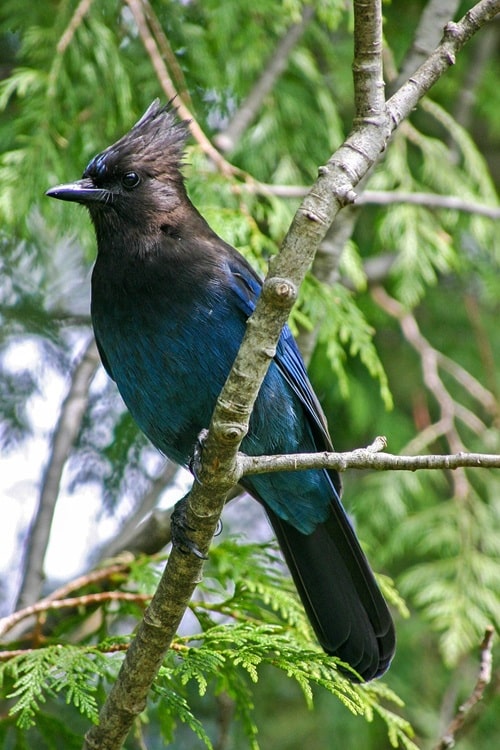
Listen to Steller's Jay Call
Females are similar in appearance to males but have fainter barring on their tails.
Juveniles have gray heads and shorter crests than adults.
Their body is gray, and their wings have no barring like adults. Bills are pale until the first molt, turning black like adults.
Mating Habits
Pairs form monogamous, long-term pair bonds, and will stay together all year on their territory.
Males guard their mates aggressively. Chasing other males who get too close to the female or nest site.
Pairs tend to stay and breed with each other only choosing another mate if one dies.
Habitat
The habitat of this bird is coniferous forests consisting of pine and oak woods.
Small groves and stands of mixed oak and redwood make up this bird's home in northern California.
Prefers woodland edges for nesting sites that open cleared spaces for food foraging.
Steller's Jay Nesting Habits
The nest is a sturdy cup of sticks and twigs lined with small roots, fibers, and mud.
Located 8 to 16 feet above the ground, on a branch, or in a crotch of a conifer.
The female lays a clutch of 2 to 6 eggs, usually 4, which are greenish-blue with brown speckles.
Incubation is done by the female for about 16 days.
The young will leave the nest in about 16 days after hatching.
| Steller's Jay Nesting Stats | |
|---|---|
| Eggs | 2 - 6 |
| Incubation | 16 days |
| Nestling Phase | 16 days |
| Broods | 1 |
Near its nest site, it is silent and shy. Pairs breed from late March to early July, with the peak in April and May.
Young may be fed for 4 weeks after fledging. Only one brood is raised each season.
Feeding Habits
Steller's Jay eats nuts, seeds, fruits, and insects. Also known to feed on the eggs and young of other birds.
Somewhat skittish in the woods, these birds quickly become accustomed to campsites and humans that provide food.
Steller's Jays will cache food in different parts of their territory. Storing seed and nuts in the ground and tucked in tree bark.
The Steller's Jay is often seen sitting quietly in treetops, surveying the surroundings.
Anting - Sunning
Sometimes you may see this bird on the ground with its wings spread out and not moving.
You may think it's playing dead or worse. Like many other birds, the Steller's Jay often suns or does what is called anting.
Sunning is just as it sounds, wings spread while the sun heats their back, hopefully encouraging any parasites to leave.
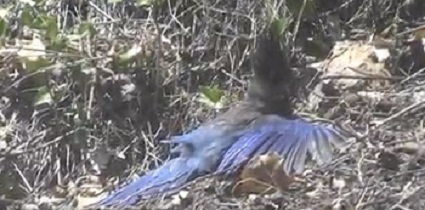
Anting is a behavior where the bird finds an ant hill and lies on top, allowing the ants to crawl where they will.
It's thought the ants secrete a substance that the parasites don't like. Sometimes the Jay will pick up the ant and rub it into its feathers.
Do Steller's Jays Migrate
Normally a permanent resident in its lower elevation range. Those that live and breed at higher elevations move to lower elevations during winter.
First-year birds may be found during winter in habitats where the birds do not breed, returning in spring.
Predators of Steller's Jay
Typical predators include Sharp-shinned Hawks, Northern Goshawks, Red-tailed Hawks, and some owls.
In the nest, predators include snakes, raccoons, and opossums.
Studies have shown that the Steller's Jay will give different calls depending on type or size of predator.
Also, how soon they returned to feed after a predator was seen or heard varied on what predator came by.
Like other Jays, these birds use antipredator displays, with mobbing (gathering in large numbers to vocally harass and fly at predators) being the primary form of defense.
Making loud calls, other Steller's Jays will come to help chase the intruder away.
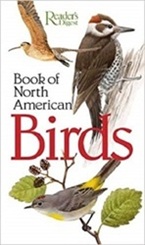
|
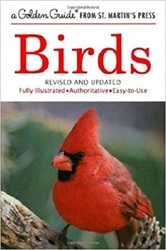
|
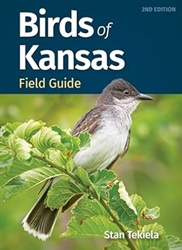
|

|
| Readers Digest Guide | Golden Guide | Your State Only | Nat-Geo Guide |






